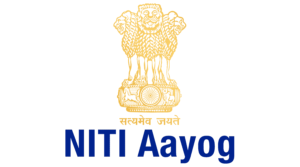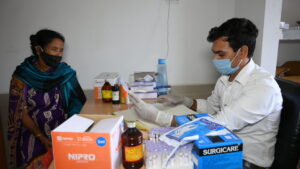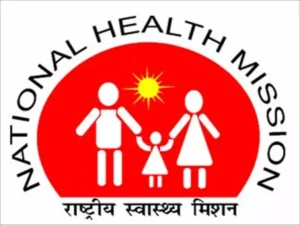Pradeep Kumar Panda

In 2017, the National Institution for Transforming India (NITI Aayog) in collaboration with the Ministry of Health and Family Welfare (MoHFW) and the World Bank initiated an annual Health Index for tracking Overall Performance and Incremental Performance across all states and Union Territories (UTs).
The objective of the Annual Health Index is to track progress on health outcomes and health systems performance, develop healthy competition and encourage cross learning among states and UTs. Health Index Scores and rankings for states and UTs are generated to assess Incremental Performance (year-to-year progress) and Overall Performance (current performance). It is expected that the exercise will help drive state/UT’s efforts towards achievement of health-related Sustainable Development Goals (SDGs) including those related to Universal Health Coverage (UHC) and other health outcomes.
Health Index is a weighted composite score incorporating 24 indicators covering key aspects of health performance. Health Index comprises of select indicators in three domains: (a) Health Outcomes; (b) Governance and Information; and (c) Key Inputs and Processes. The indicators are selected on the basis of their importance and availability of reasonably reliable data at least annually from existing data sources such as the Sample Registration System (SRS), Civil Registration System (CRS) and Health Management Information Systems (HMIS).
A Composite Index is calculated as a weighted average of various indicators, focused on measuring the state of health in each state and UT for a Base Year (2018-19) and a Reference Year (2019-20). Given the focus on performance, the Health Outcomes are assigned the highest weight. Four rounds of Health Index have been undertaken and this report relates to the fourth round. For generation of ranks, to ensure comparability among entities, the states are classified into three categories (Larger States, Smaller States and UTs). In this round, all the states and UTs participated except West Bengal, and the UT of Ladakh was not included due to non-availability of data.
The Health Index Round IV 2019-20 does not capture the impact of COVID-19 on health outcomes or any of the other indicators as the Index Performance relates to Base Year (2018-19) and Reference Year (2019-20), largely the pre-COVID-19 period.

The learnings from the previous three rounds of the Health Index were taken into account to develop the Health Index Round IV 2019-20. For the fourth round of the Health Index, review of indicators was undertaken and three new indicators were added for Larger States. These are Maternal Mortality Ratio (MMR), proportion of pregnant women who received 4 or more antenatal care check-ups (ANC), and level of registration of deaths. The indicator relating to Community Health Centres and Sub-District Hospitals (CHCs/SDHs) with grading of 4 points or above was dropped and the definition of two indicators, one related to data integrity measure and second related to quality accreditation of public health facilities, was refined.
Among the Larger States, Kerala, Tamil Nadu and Telangana emerged among the best three performers in terms of Overall Performance. Uttar Pradesh with the lowest Overall Reference Year (2019-20) Index Score ranked at the bottom (Rank 19) in Overall Performance, however, it ranked at the top in terms of Incremental Performance by registering the highest incremental change from the Base Year (2018-19) to Reference Year (2019-20). On the other hand, Kerala and Tamil Nadu were top two performers in terms of Overall Performance with the highest Reference Year (2019-20) Index Scores but ranked twelfth and eight respectively in terms of Incremental Performance. Telangana performed well both in terms Overall Performance as well as Incremental Performance and secured the third position in both instances. For the fourth consecutive round Kerala emerged as the best performer in terms of Overall Performance. Among the Smaller States, Mizoram emerged as the best performer in Overall Performance as well as Incremental Performance while among UTs, Delhi and Jammu & Kashmir ranked among the bottom UTs in terms of Overall Performance but emerged as the leading performer in terms Incremental Performance.
For a vast majority of the states and UTs, there has been a shift in the Overall Performance ranking from Base Year (2018-19) to Reference Year (2019-20). Among the 19 Larger States, four improved their rankings while five states deteriorated in their rankings from Base Year (2018-19) to Reference Year (2019-20), and ten states retained their Base Year (2018-19) ranks. Three out of the eight Smaller States improved their rankings, four deteriorated while one retained its Base Year (2018-19) rank. Compared to the Base Year (2018-19), four UTs improved their rank while the rank of three UTs deteriorated in the Reference Year (2019-20). Assam made the maximum improvement by moving up 3 ranks (from 15 to 12) while on the other hand Andaman & Nicobar registered the maximum drop in rank (down from 4th to 7th rank).
The gap in the Overall Performance between the best and the worst performing Larger State and UTs narrowed in the current round of the Health Index, while it increased for the Smaller States. Among the Larger States, Kerala was at the top with the Index Score of 82.20 and Uttar Pradesh at the bottom with the Index Score of 30.57, in the Reference Year (2019-20). The gap between the best and worst performing Larger States was 56.54 points in Base Year (2018-19) which decreased to 51.63 points in the Reference Year (2019-20). In case of Smaller States, Mizoram was at the top with Index Score of 75.77 and Nagaland at the bottom with Index Score of 27.00. Among the Smaller States, the gap between the best and the worst performer increased from 46.40 points in the Base Year (2018-19) to 48.77 points in Reference Year (2019-20). Among the UTs, Dadra & Nagar Haveli and Daman & Diu (DH & DD) was at the top with Index Score of 66.19 and Andaman & Nicobar at the bottom with Index Score of 44.74. The gap between the best and worst performer UT decreased from 35.94 in the Base Year (2018-19) to 21.45 in Reference Year (2019-20).

Nearly half the states and UTs did not reach the half way mark in the Composite Overall Index Score, and despite good performance, even the top ranking states and UTs could benefit from further improvements. The maximum Index Score that a state/UT can achieve is 100. In the case of Larger States, the highest observed Overall Index Score of 82.20 is for Kerala, followed by 72.42 for Tamil Nadu, 69.96 for Telangana and 69.95 for Andhra Pradesh which is quite a distance from the frontier (100 points). In case of Smaller States, the Front-runner states were Mizoram with Index Score of 75.77 and Tripura with Index Score of 70.16. Among the UTs, the Front-runners were DH & DD and Chandigarh with Index Scores of 66.19 and 62.53 respectively. This clearly indicates that there is room for improvement (to reach to the potential score of 100) for all states/UTs, including the best performing states/UTs. There is an urgent need to accelerate efforts to narrow the performance gap between the states/UTs as 50 percent of the Larger States, 50 percent of Smaller States and 43 percent of the UTs did not even reach the halfway mark in terms of the Composite Overall Index Score.
The incremental changes in Health Index Scores from Base Year (2018-19) to Reference Year (2019-20) varied significantly across states and UTs, with a vast majority of Larger States registering at least some improvement. Fourteen out of the 19 Larger States, four out of the eight Smaller States and five out of the seven UTs showed improvement in Health Index Scores from Base Year (2018-19) to Reference Year (2019-20).
Only five Larger States and two Smaller States, showed good Overall Performance and continued to improve on their Health Index Score from the Base Year (2018-19) to Reference Year (2019-20). Mizoram and Telangana were the only two states that demonstrated strong Overall Performance and showed most improvements in the Incremental Performance between the Base Year (2018-19) and Reference Year (2019-20). Among the Larger States, Telangana, Maharashtra, Kerala, Tamil Nadu and Andhra Pradesh showed strong Overall Performance and also registered improvements in Incremental Performance. Assam and Uttar Pradesh, though among the bottom one-third performers in Overall Performance, did exceedingly well in Incremental Performance recording the highest progress from Base Year (2018-19) to the Reference Year (2019-20). Rajasthan was the weakest performer both in terms of Overall Performance and Incremental Performance. In the case of Smaller States, Mizoram and Tripura registered strong Overall Performance, and at the same time showed improvements in Incremental Performance. In case of Smaller States, although, Meghalaya was in the category of bottom one-third performers in terms of Overall Performance, it recorded the highest progress from Base Year (2018-19)to the Reference Year (2019-20). None of the UTs, emerged as a strong performer in terms of Overall and Incremental Performance. Although, Delhi, Jammu & Kashmir and Lakshadweep were in the category of bottom one-third performers in terms of Overall Performance, they did exceedingly well in Incremental Performance recording the highest progress from Base Year (2018-19) to the Reference Year (2019-20). Table ES.3 provides an overview of the categorization of states and UTs based on Incremental Performance and Overall Performance for the Health Index Round IV 2019-20.
There is larger variation in domain-specific performance of the states/UTs. 47 percent of the Larger States and 29 percent of the UTs performed best in Governance and Information domain compared to any other domain. 47 percent of the Larger States, 88 percent the Smaller States and 71 percent of the UTs performed best in the Health Outcomes domain than any other domain. Only five percent of the Larger States and 12 percent of Smaller States and none of the UTs performed best in Key Inputs and Processes domain compared to any other domain.
There are wide disparities in the Health Outcomes Domain Index Scores across states and UTs. Among the Larger States, the Health Outcomes Index Score of the best performing state Kerala (85.97), was about three and half times that of the worst performing state, Uttar Pradesh (25.64). In case of Smaller States, the Index Score of the best performing state Tripura (85.01), was 2.7 times that of the lowest performer Nagaland (32.00) and for best performing UT (Chandigarh), the Index Score at 78.49 was 1.5 times that of the lowest performer Puducherry (52.19). The gap between the best and the worst performing states and UTs narrowed on health outcomes in the fourth round of the Health Index. Fourteen of the 19 Larger States, four out of eight Smaller States and three out of seven UTs registered an improvement in Health Outcomes from Base Year (2018-19) to Reference Year (2019-20). The largest increase in Health Outcomes Index Scores was observed by Assam (7.10 points) among Larger States, Meghalaya (25.29 points) among Smaller States and Delhi (18.88 percentage points) among the UTs. The states and UTs with largest decline in Index Scores in this domain were Chhattisgarh (-2.65 points), Goa (-22.30 points) and Chandigarh (-12.22 points).

In the Governance and Information domain, majority of states/UTs registered an increase in Index Scores from Base Year (2018-19) to the Reference Year (2019-20). Eleven Larger States, five Smaller States and three UTs registered an increase in the Index Scores in the Governance and Information domain. The 11 Larger States that registered increase include all the Empowered Action Group (EAG) states, except Madhya Pradesh. Among the eight Larger States that registered decrease in Index Scores, Himachal Pradesh registered the highest decline of 18 percentage points. Among the Smaller States and UTs, Mizoram and Lakshadweep registered the highest increase while Tripura and DH &DD registered the highest decline in the Index Score in this domain. The gap between the best and the worst performing Larger States and Smaller States has increased in the Reference Year (2019-20) but decreased among UTs.
There are wide disparities in the Key Inputs and Processes Domain Index Scores across states and UTs. Among the Larger States, the Key Inputs and Processes domain score of the best performing state Tamil Nadu (71.06) was 4.6 times that of the worst performing state of Bihar (15.31). In case of Smaller States, the Index Score of the best performing state Mizoram (61.90) was 2.6 times that of the lowest performer Manipur (23.46). Among the UTs, the score of the best performer DH & DD (60.30) was about two times that of the lowest performer Lakshadweep (31.28). The gap between the best and the worst performers has increased among the Larger States and Smaller States whereas it declined for UTs. Fifteen out of the 19 Larger States, four out of eight Smaller States and four out of the seven UTs registered improvements in Key Inputs and Processes domain from Base Year (2018-19) to Reference Year (2019-20). The largest increase was observed by Madhya Pradesh (17.54 points) among Larger States, Meghalaya and Mizoram (10.40 and 10.32 points respectively) among Smaller States and Puducherry (6.69 points) among UTs. The states/UTs with the largest decline were Assam (-10.13 points), Sikkim (-6.48 points) and Chandigarh (-11.11 points).
Among the Larger States, Telangana is the only state that demonstrated strong Overall Performance as well as Incremental Performance while Rajasthan reported weak performance on both counts. Telangana emerged as strong performer on both Overall and Incremental Performance as for several indicators it had attained the best possible performance. For example, it attained universal full immunisation of children and total case notification of tuberculosis; had fully functional First Referral Units (FRUs) and all Primary Health Centres (PHCs) and urban PHCs functional as Health and Wellness Centres (HWCs); operation theatres and labour rooms of all district hospitals certified under LaQshya and Kayakalp scores more than 70 percent; and no vacancies of ANMs in Sub Centres and Medical Officers in PHCs. In terms of Incremental Performance, Telangana made major gains in the Key Inputs and Processes domain with nearly half the indicators in the Fully Achieved or Most Improved or Improved category; against 19 percent for Rajasthan.
In case of Smaller States, Mizoram emerged as best performer and Arunachal Pradesh and Manipur as the worst performers, both in terms of Incremental and Overall Performance. Mizoram excelled in Overall Performance because in the Reference Year (2019-20), nearly 60 percent of the total indicators were in the top one-third category compared to less than one-sixth of the indicators in Arunachal Pradesh and Manipur. In the Incremental Performance from the Base Year (2018-19) to Reference Year (2019-20), Mizoram performed well in all three domains of Health Index, whereas Manipur observed decline in the Health Outcomes and Key Inputs and Processes domains, and Arunachal Pradesh observed decline in the domain of Health Outcomes.

The Incremental Performance on various indicators varied widely across Larger States between the Base Year (2018-19) and Reference Year (2019-20): Vast majority of Larger States registered improvement in performance across the key health outcome indicators (NMR, U5MR, Sex Ratio at Birth and MMR). Chhattisgarh was the only Larger State to have shown deterioration in all the key health outcome indicators except for U5MR. Madhya Pradesh, Haryana and U.P reported deterioration in performance across both NMR and U5MR. The indicators where substantial number of Larger States reported deterioration in performance between the Base Year (2018-19) and Reference Year (2019-20) include full immunisation coverage, institutional deliveries, average occupancy of state level 3 key posts, average occupancy of CMOs, number of days for transfer of NHM funds to implementing agency, level of registration of births and share of state government heath expenditure to total state expenditure. On some of the quality indicators such as public health facilities with accreditation certificates (e.g. NQAS/ NABH) and CHCs certified under LaQshya, the level of performance across both Base Year (2018-19) and Reference Year (2019-20) was low. On three Health Outcome indicators, viz, modern contraceptive prevalence rate, total case notification of TB, and proportion of people living with HIV (PLHIV) on antiretroviral therapy (ART), vast majority of the Larger States reported improvement in performance between the Base Year (2018-19) and Reference Year (2019-20).
There is a general negative correlation between the Health Index Scores and the poverty levels of states and UTs as measured by the Multidimensional Poverty Index recently released by NITI Aayog. However, many states with the same level of poverty performed better in Health Index indicating that factors beyond income determine health sector performance. For example, Telangana performed significantly better in Health Index than Haryana or Jammu & Kashmir despite having same level of poverty. On the other hand, states such as Arunachal Pradesh, Manipur and Bihar with almost the same level of performance on the Health Index had vastly different poverty levels. The lessons from these scenarios may provide some insights on how to improve health situation in the states/UTs with similar or higher level of poverty. Similarly, though there was a general positive correlation between the Health Index Scores and the economic development levels of states and UTs as measured by the Statewise Per Capita Net State Domestic Product (Per Capita NSDP), some of the states/UTs with low per capita NSDP have performed better on the Health Index than the similarly placed states/UTs. Furthermore, there seems to be no or little association between the Per Capita NSDP of the states/UTs and their Incremental Performance from the Base Year (2018-19) to Reference Year (2019-20). This suggests that with improved management and governance, the state/UT performance can improve irrespective of the economic or poverty level of the state/UT.
The Health Index is a useful tool to measure and compare the Overall Performance and Incremental Performance across states and UTs over time and nudging the states and UTs to shift the focus from inputs and outputs to outcomes. The previous three rounds of Health Index have triggered many useful discussions, including how to identify barriers and motivate actions using data, and how to promote positive competition and learning among the states and UTs. The MoHFW’s decision to link the Index to incentives under the National Health Mission (NHM) has been instrumental in shifting the focus from budget spends, inputs and outputs to outcomes by shining the light on states/UTs that have shown most improvement. Based on the interim findings of the fourth round of the Health Index, MoHFW provided 10 percent of the state/UTs’ total NHM funds as NHM incentive based on agreed conditionalities.
The Health Index has strengthened the culture of use of data at the state/UT level to monitor performance and is contributing to the agenda of improving availability, quality and timeliness of data. In most states/UTs, the annual performance of the state/UT has been monitored at the highest level of the government using the Health Index report. Also, several states such as Andhra Pradesh,Assam, Chhattisgarh, Gujarat and Karnataka have replicated the Index and are regularly monitoring district performance using similar tools. The availability, quality and timeliness of data has also by and large improved. For instance, the Maternal Mortality Ratio, a very important health outcome indicator generated by SRS, has recently become available for all Larger States except Himachal Pradesh (earlier it was available only for 13 states), and included in the fourth round of Health Index. The process of data validation and discussions among state and central level programme managers is helping reinforce good practices related to data scrutiny and validation of HMIS data, and thus improving quality of HMIS data. Also, the dialogue has contributed in strengthening definition of indicators (e.g. TB case notification, TB treatment success rate), revision in the denominators (e.g. coverage indicators such as full immunisation coverage), adaptation of indicators to reflect variations in the urban health systems etc. The discussions have also stimulated improvements in indicators such as defining functionality of facilities based on population norms, third party sample verification of data for ascertaining functionality of Health and Wellness Centres (HWC), and expanding the range of indicators for tracking quality at health facilities.
India is committed to achieving the Sustainable Development Goals (SDGs), including those related to Universal Health Coverage (UHC) and other health outcomes.
























